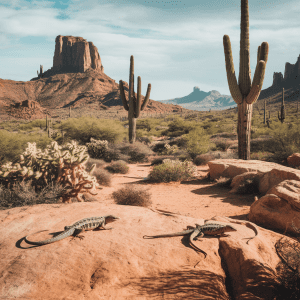Ever packed your bags, rallied the kids, and embarked on a family adventure, only to find yourselves staring blankly at a tiny, scaly creature on a tree stump, wondering if it's a lizard or a well-disguised leaf? You're not alone! Lizard spotting, as thrilling as it is, can be a tricky business for beginners. And while you may be a pro at packing the perfect picnic or choosing the most scenic hiking trail, we understand that deciphering the world of these elusive reptiles might be a bit of a challenge. But fear not, fellow adventurers! You've just stumbled upon the treasure map to navigating this fascinating world. Consider this your comprehensive guide to the enchanting art of lizard spotting, brimming with handy tips, easy-to-follow advice, and nuggets of wisdom. We're here to transform you from a confused spectator into a confident lizard spotter. From distinguishing a Draco from a Skink to mastering the subtle art of patience in the field, this guide is all about making lizard spotting a fun, engaging, and educational experience for the whole family. So, grab your binoculars, put on your explorer hat, and prepare to embark on a journey of discovery and learning that promises to be as captivating as the lizards themselves. Because let's face it, nothing quite matches the thrill of spotting your first lizard in the wild, right? And we're here to make sure that moment is just the first of many. So, welcome aboard, future lizard aficionados! Let's dive right into the mesmerizing world of lizard spotting tips and uncover the magic that awaits us.
"Getting Started: Your First Steps into the World of Lizard Spotting"
As the sun gently peeks over the horizon, you find yourself in the heart of nature, binoculars in hand, eagerly scanning the landscape. It's the start of a new adventure—one that promises excitement, discovery, and yes, a bit of mystery. Welcome to the captivating world of lizard spotting. You might be wondering, why lizards? Well, lizards, with their vibrant hues and fascinating behaviors, offer a delightful peek into the magic of nature. And the best part? You don't need to be a seasoned explorer or a biology whiz to embark on this journey. All you need is a keen eye, a dash of patience, and of course, our handy lizard spotting tips. Let's begin with the basics. What do you need to spot lizards? The answer is surprisingly simple. Apart from your adventurous spirit, you'll need a good pair of binoculars, a reliable field guide to identify different species, and comfortable outdoor clothing that blends with the environment. Remember, lizards are sensitive to movement and noise, so you'll want to tread lightly and speak softly. Think of yourself as a detective on a mission, trying to blend into the crowd while keeping an eye on the target. Now, where do you find lizards? Lizards are cold-blooded creatures, which means they rely on external sources for warmth. Therefore, sunny spots like rocks, tree trunks, or near water bodies are your best bet. Early morning or late afternoon, when the sun isn't too harsh, is the ideal time to spot these elusive creatures. Let's talk a bit about lizard behavior. Understanding their behavior can give you valuable insights and make your lizard spotting expedition more fruitful. For instance, lizards are known to bask in the sun to regulate their body temperature. So, if you spot a lizard sunning itself, be patient and observe. You might witness some interesting behavior, like push-ups or head bobbing, which are part of their communication. As you venture into the world of lizard spotting, remember that every expedition is a learning experience. You might not spot a lizard on your first try, and that's okay. It's all part of the journey. Keep exploring, keep learning, and most importantly, keep enjoying the process. These lizard spotting tips are just the beginning. As you delve deeper, you'll uncover a wealth of knowledge and experience that will enrich your family's travel adventures. So grab your binoculars, lace up your boots, and step into the thrilling world of lizard spotting. Happy exploring!
"Know Your Lizards: A Simple Guide to Identifying Different Species"
Diving into the world of lizard spotting can feel a bit like stepping into a wild, colorful, and occasionally scaly wonderland. It's an adventure filled with unexpected surprises, fascinating creatures, and unforgettable family memories. But to make the most of this unique experience, you need to have a good understanding of different lizard species. And that's where our handy guide to identifying different species comes in. Imagine this: you're hiking with your family on a sunny afternoon. Your youngest spots a small creature darting across the path. "Look, a lizard!" they shout. You all gather around, excited and curious. But what kind of lizard is it? This is where our lizard spotting tips can turn a simple sighting into a fun and educational experience. First, take note of the lizard's size and shape. Lizards come in all shapes and sizes, from the petite, 3-inch-long common house gecko to the impressive, 10-foot-long Komodo dragon. Is the lizard you spotted small and sleek or large and robust? This can give you a hint about its species. Next, observe the color and pattern. Lizards are true chameleons when it comes to their appearance, and no, we're not just talking about the actual Chameleon species! From the vibrant green of an iguana to the intricate pattern of a bearded dragon, the variety is astounding. Identifying the color and pattern can be one of the most fun and challenging parts of lizard spotting. Then, look at the lizard's behavior. Is it basking in the sun, indicating it might be a cold-blooded species like the iguana? Or is it skittering across the sand quickly, hinting at a sand-dwelling species like the spiny-tailed lizard? Lastly, don't forget the habitat. Are you in a desert, a forest, or perhaps near a body of water? Different species of lizards inhabit different environments. For example, the marine iguana is the only lizard that swims in the sea, while the Gila monster prefers dry desert habitats. These lizard spotting tips can make your next family outing an exciting and educational experience. Remember, every lizard sighting is an opportunity to learn and explore. With a bit of practice and patience, you'll soon become a pro at identifying different species. After all, isn't it fascinating to think that with every step we take in nature, we're stepping into a world that's home to these incredible creatures? In our pursuit of transparency and openness, we encourage you to share your lizard spotting experiences and tips with us. The world of lizards is vast and varied, and there's always something new to learn. So let's embark on this adventure together, exploring, learning, and sharing every step of the way. Happy lizard spotting!
"In the Field: Practical Lizard Spotting Tips for Beginners"
Building on earlier insights, it's time to put theory into practice with these lizard spotting tips. Let's dive right in, shall we? Venturing into the wild for a day of lizard spotting is an adventure like no other. As you lace up your boots and pack your binoculars, remember the excitement of discovery lies in patience and observation. So, before you rush off into the underbrush, take a moment to tune into your surroundings. You see, lizards are creatures of habit. They love basking in the sun, hiding in leaf litter, or lounging on tree trunks. Spotting them is a bit like a treasure hunt—you have to know where to look! Now, onto the practicalities. Wearing the right clothing is paramount. You're not on a fashion runway, so leave the neon colors and shiny fabrics at home. Instead, opt for earth-toned clothes that blend in with the natural environment. This way, you're less likely to scare off our cold-blooded friends. Let's talk timing. Early mornings and late afternoons are prime time for lizard spotting. These creatures are ectothermic, meaning they depend on external sources for body heat. So, they're most active when the sun is not at its peak. Timing your exploration around these hours increases your chances of seeing these critters in action. Patience is key in this endeavor. You might be tempted to rush from spot to spot, but that could scare away potential sightings. Instead, choose a promising location and wait quietly. Look closely at rock crevices, tree trunks, and sunny patches. Lizards are masters of camouflage, so keep your eyes peeled. Remember, lizard spotting is not just about seeing, but also about listening. These creatures make various sounds—from hisses to clicks—that can alert you to their presence. So, train your ears to pick up these subtle signals. And finally, a word about respect. As you embark on your lizard spotting adventure, remember to respect these creatures and their habitats. Avoid disturbing them or their surroundings. After all, we're just visitors in their world. By following these lizard spotting tips, you're not just embarking on a thrilling family adventure. You're also nurturing a deeper appreciation for nature and its inhabitants in your children. This shared experience, filled with discovery and wonder, will create lasting memories and maybe even spark a lifelong love for wildlife. So, there you have it. With these practical lizard spotting tips, you're ready to venture into the wild. Happy hunting, or rather, happy spotting!
"Ask the Experts: Frequently Asked Questions About Lizard Spotting"
Continuing our journey through the exciting world of lizard spotting, let's delve into some common queries and concerns. Think of this as your own personal FAQ session with the experts in the field. So, buckle up and let's dive into the fascinating realm of lizard spotting tips. You might be wondering, "What's the best time to spot lizards?" It's a great question! Typically, lizards are more active during the daytime, especially in the morning when they bask in the sun to warm up their bodies. So, if you're planning a family outing, make sure to set your alarm early to catch these little sunbathers in action. "But what if we don't see any lizards?" you might ask. Well, don't fret. Patience is a key virtue in lizard spotting. These creatures are masters of camouflage, and it may take some time before you spot one. But remember, the joy is in the journey, not just the destination. Engage your kids in the process—make it a game of who can spot the first lizard. This not only makes the experience more fun but also fosters a love for nature in your little ones. Another common question is, "Are there any safety measures we should be aware of?" Absolutely! While most lizards are harmless, it's always better to be safe than sorry. Make sure to keep a safe distance and avoid touching or picking up the lizards. Also, ensure your family is equipped with appropriate gear such as sturdy shoes and hats to protect against the sun. By now, you might be thinking, "Lizard spotting seems like a lot of work. Is it really worth it?" To that, we say, absolutely! Not only is lizard spotting a fun and educational activity for the whole family, but it also offers an opportunity to bond and create lasting memories. Plus, imagine the look of awe on your child's face when they spot their first lizard—that alone is worth it! In the world of lizard spotting, there's always something new to learn. Whether you're a novice or a seasoned pro, these lizard spotting tips can elevate your experience and make your next family adventure unforgettable. So, what are you waiting for? Get out there and start spotting! Remember, every question you ask, every step you take, and every lizard you spot brings you closer to becoming a lizard spotting aficionado. So, keep those queries coming and let's continue to explore this fascinating world together. After all, transparency and openness are the building blocks of any learning journey.
Conclusion
And there you have it, folks! We've journeyed together through the fascinating world of lizard spotting, from your first steps to practical field tips, right up to expert insights. Now, the adventure truly begins. Isn't it amazing how something as simple as lizard spotting can turn an ordinary trip into a captivating exploration? And hey, who knew there were so many diverse species right under our noses? With these handy lizard spotting tips, you're now equipped to add a dash of discovery and education to your family outings. Remember, every great lizard spotter started somewhere. You might not be an expert today, or even tomorrow. But with patience, openness, and a keen eye, you'll soon be distinguishing between a Leopard Gecko and a Green Anole with the best of them. So, here's your call to action, folks. Step out into the world, binoculars in hand, and start exploring. Whether it's a trip to the local park or a family vacation, let lizard spotting add a touch of wonder to your journeys. Who knows, you might even inspire a future herpetologist in your family! After all, it's not just about spotting lizards—it's about embracing the beauty of nature, fostering curiosity, and creating memorable experiences with your loved ones. That's the magic of travel, and now, you've got a unique way to make it even more enchanting. So, what are you waiting for? The world of lizard spotting awaits! Start your journey today, and remember to keep an eye out for those critters. They're more than just creatures; they're gateways to a world of discovery and learning. Happy spotting, adventurers!



